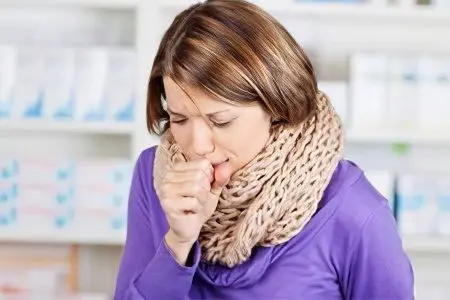Contents
Purulent bronchitis is an inflammatory process in the structure of the bronchial tree, which is accompanied by the discharge of a purulent secret. Purulent bronchitis is always accompanied by a bacterial infection and is a type of chronic or acute bronchitis.
During coughing, the patient is separated by sputum containing purulent inclusions. The disease can be both primary and secondary. That is, it can occur on its own, or be the result of inflammation of the respiratory system, for example, tuberculosis, bronchiectasis, chronic pneumonia, etc.
Causes of purulent bronchitis

The causes of purulent bronchitis are often mixed, that is, there is a layering of exogenous, endogenous, infectious and non-infectious factors on top of each other.
Non-infectious exogenous causes of purulent bronchitis:
Pollution of the environment, which is reflected in the inhaled air;
Active or passive smoking, where tobacco smoke has a pathogenic effect;
Allergy;
Stress;
Inhalation of household and industrial pollutants;
Overheating and hypothermia of the body.
All these factors contribute to excessive irritation of the mucous membrane lining the bronchi, and create favorable conditions for the penetration of bacterial agents into their deep structures.
Infectious causes of purulent bronchitis:
Infection with viruses (parainfluenza, influenza, rhinovirus infection, etc.);
Penetration into the body of bacterial flora (pneumococci, staphylococci, Haemophilus influenzae, Pseudomonas aeruginosa, etc.);
Mycotic lesions of the respiratory tract, followed by the addition of a bacterial infection;
Acute bronchitis, which was caused by a viral-bacterial flora and was not properly treated, often causes the development of purulent bronchitis.
Endogenous causes of purulent bronchitis:
Alcohol abuse;
senile age;
Excess body weight;
Immunodeficiency states;
Lack of vitamins.
The course of the disease will be aggravated by the presence of concomitant inflammation: chronic tonsillitis, sinusitis, COPD, other specific processes, such as pulmonary tuberculosis.
Symptoms of purulent bronchitis
Symptoms of purulent bronchitis never occur against the background of a person’s complete health. The development of the pathological process is always preceded by a cold with its clinical manifestations (rhinitis, tracheitis, tonsillitis), or an allergic reaction with lacrimation, rhinitis, cough, or hypothermia, etc.
The immediate symptoms of purulent bronchitis are:
Excessive weakness.
Increased sweating.
Loose cough with thick sputum. Its color varies from light yellow to deep green. Sputum in some cases may have an unpleasant odor. When the disease process is in the acute phase, up to 250 ml of purulent sputum can be separated per day.
If the process becomes chronic, then sputum is likely to be separated periodically, that is, at times of exacerbation of the disease.
Any physical activity exceeding the minimum is accompanied by the occurrence of shortness of breath and rapid fatigue of the patient.
Perhaps the accession of hemoptysis, since during the illness the bronchial mucosa is characterized by increased vulnerability.
If purulent bronchitis is not treated, then obstruction and blockage of the bronchial passages with purulent contents is possible. In this case, the cough intensifies, breathing becomes wheezing. Probably, the development of complications such as cor pulmonale or emphysema.
Treatment of purulent bronchitis
At the time of exacerbation of purulent bronchitis, the patient must adhere to strict bed rest. It is important to exclude any traumatic and irritating effect on the bronchi. This applies to smoking, inhalation of allergens, dust, polluted air, etc.
The main treatment of purulent bronchitis is the appointment of antibacterial drugs to irradiate the infection. It is these drugs that most effectively fight the pathogens of purulent bronchitis, due to the ability to accumulate in bronchial secretions in high concentrations.
In order for sputum to be more effectively and easily separated and removed from the respiratory tract, patients with purulent bronchitis are prescribed expectorants and mucolytics. These drugs are taken orally and used for inhalation for bronchitis. It is possible to perform sanitation of the bronchi with bronchoalveolar lavage.
Physiotherapy (electrophoresis, inductothermy, etc.), chest massage, physiotherapy exercises are performed as auxiliary methods of treatment, vitamin supplements are prescribed.
As a rule, purulent bronchitis does not pose a threat to human life, and with timely and adequate treatment, the prognosis for a complete recovery is favorable. The loss of a person’s ability to work occurs for a short time attributable to the period of exacerbation. However, if treatment is ignored, serious complications may develop that threaten the life of the patient.
[Video] Dr. Evdokimenko – Cough, bronchitis, treatment. Weak lungs. How to treat? What many doctors don’t know about:









